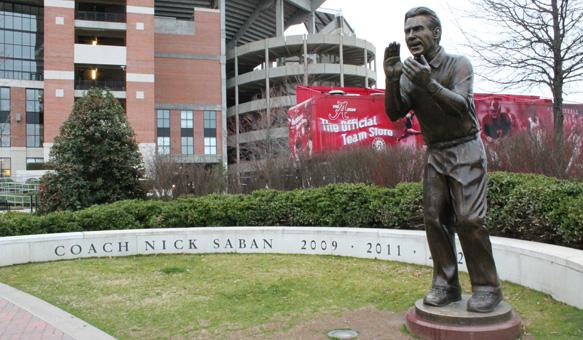“It was one of the most challenging and rewarding two and a half months in my short art career,” said Davis, a native of West Blocton who came back to school after a short hiatus to try his hand at new art mediums. “I had never tried sculpting an actual live person before Coach Saban.”
Davis was studying sculptural ceramics in The University of Alabama’s art department during the early summer of 2010 when the faculty received an unusual call from the athletic department. Terry Saban wanted to commission a local artist to create the nine-foot statue of her husband that would be displayed on the University’s Walk of Champions.
Art professors Daniel Livingston and Craig Wedderspoon supervised the project and first approached Davis with a proposition to be the artist.
“They told me on a Thursday evening to come up with some sketches, and that next Friday morning at 8:05 a.m. I was in Coach Saban’s office getting asked by the coach himself if I felt confident translating my sketch into a sculpture,” Davis said.
And he was. From that date, Davis said he jumped into a whirlwind of sketching, sculpting and revising with the Sabans. While still enrolled in classes, he spent between 25 and 35 hours a week on the project, forming a small-scale model from aluminum wire bulked up with paper and plasticine, an oil-based clay that doesn’t dry out.
Using plasticine allowed Davis to sculpt the intricate details of Saban’s face with precision and to continuously adapt his rendering of the head coach to accommodate Nick and Terry Saban’s requests. He did the majority of his work in Wedderspoon’s on-campus art studio.
Davis was chosen because of his art background. At the time, he was one of the only students in the department of art and art history with extensive work in portraiture and the human form.
Livingston said he felt confident in Davis’s ability to craft the sculpture.
“Jeremy was a good student and is a talented artist, and it was an absolute joy getting to work with Mrs. and Coach Saban,” he said.
A quick glance down the Walk of Champions by Bryant-Denny Stadium reveals a more subtle challenge Davis faced as a new student artist designing the statue. Nick and Terry Saban wanted to embody a distinctively different attitude than that of the other statues, which shows the coaches in more formal, straight stances, wearing suits.
Saban’s statue, however, depicts the coach in a “clapping hands” pose. He also sports his traditional gameday gear – khakis and a collared shirt.
“They wanted him in a teaching moment where he was clapping and urging his players on,” Davis said. “This was ultimately their choice.”
A company in Oklahoma called MTM Recognition created all four of the other statues on the Walk of Champions and produced the full-size Saban statue from Davis’s small model. Davis’s opportunity to be the first student to design one of the statues was mainly the result of Terry Saban’s desire to be actively involved in the creation. She frequently met with Davis to provide feedback and insight into the details of the coach’s face.
“Coach Saban was generous enough to let me get some 360 degree shots of him in pose.” Davis said. “Plus, I watched the games on TV and paused it and sketched quite a bit. He was never available for a live sitting, of course.”
The artist completed his model by the conclusion of the summer of 2010, and the finished statue was unveiled at the A-Day scrimmage game the following April.
Davis said the experience of making the statue as a student brought with it a great pressure to prove himself. He received extensive press coverage in the weeks leading up to the statue’s unveiling. Many said they were impressed with the fact that an undergraduate at the University had been entrusted with such an honor.
“It’s cool that instead of paying millions of dollars to get some outside source, we said, ‘Look at the talent we have here on campus. Why don’t we use it?’” said Margaret Stran, assistant director of the University’s adapted athletics program.
Davis, who graduated in 2012 with a degree in sculptural ceramics and printmaking, agreed.
“I am very thankful for the experiences [I received] while in school at Alabama,” he said. “I learned a great deal about myself and about the art world.”









